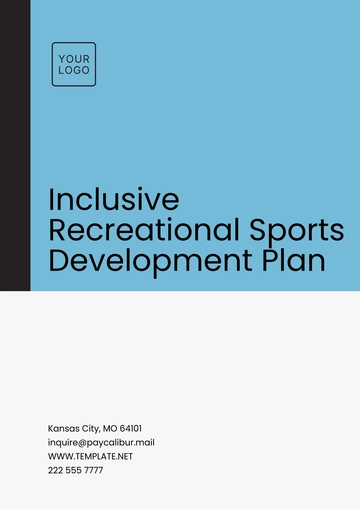Free Sports Governance Policy Development Plan

Prepared by: [Your Name]
Date: June 12, 2050
1. Introduction
The development of a robust sports governance policy is vital for ensuring transparent, accountable, and fair practices in managing sports organizations. This plan outlines the objectives, strategies, and actionable steps necessary to establish effective governance frameworks that align with global standards and best practices.
1.1 Background
Sports governance encompasses the administration and oversight of sporting bodies and events. Recent challenges such as corruption scandals, doping violations, and lack of inclusivity underscore the urgent need for comprehensive governance policies to uphold the integrity of sports.
1.2 Objectives
Enhance transparency and accountability in sports organizations.
Promote ethical practices and integrity across all sporting activities.
Ensure compliance with international governance standards and legal requirements.
Foster inclusivity and equitable participation for diverse groups.
Strengthen stakeholder engagement and promote open communication.
2. Governance Framework
A clear and structured governance framework is critical for achieving the outlined objectives. This section defines the components and oversight mechanisms necessary for effective governance.
2.1 Structural Components
Component | Description |
|---|---|
Governing Body | Provides overall strategic direction, accountability, and oversight. |
Committees | Specialized groups handling critical areas such as ethics, compliance, diversity, and audit. |
Policy Framework | A suite of comprehensive policies governing operations, conduct, and decision-making processes. |
Code of Conduct | Detailed ethical guidelines outlining responsibilities and expected behavior for all stakeholders. |
Compliance Office | Dedicated team to ensure adherence to policies and address violations effectively. |
2.2 Oversight Mechanisms
Regular audits of governance practices.
Whistleblower protection programs to encourage reporting of misconduct.
Periodic policy reviews for alignment with evolving standards.
External evaluations by independent governance experts.
Data-driven monitoring systems to track policy compliance in real time.
3. Policy Development Process
A systematic approach to policy development ensures inclusivity, accuracy, and efficiency. The following steps outline this process:
3.1 Consultation and Stakeholder Engagement
Stakeholder input is vital for creating a policy that addresses diverse needs and perspectives. The engagement process includes:
Identifying stakeholders such as athletes, officials, administrators, sponsors, and fans.
Conducting surveys and structured interviews for data gathering.
Hosting forums and focus groups for collaborative discussions.
3.2 Drafting and Revision
Policy drafting involves creating and refining a document that integrates feedback and best practices:
Developing a comprehensive draft policy.
Aligning the draft with international standards and legal frameworks.
Seeking additional stakeholder feedback for iterative improvements.
3.3 Approval and Implementation
The finalized policy undergoes approval and is rolled out effectively:
Submission to the governing body for ratification.
Communication of the policy through official channels and media.
Organizing training sessions for stakeholders to ensure understanding and compliance.
4. Monitoring and Evaluation
Continuous monitoring and evaluation are necessary to measure the policy’s success and identify areas for improvement.
4.1 Performance Indicators
Key performance indicators (KPIs) will be tracked to assess governance effectiveness:
Compliance rates with governance frameworks.
Frequency and resolution rate of governance-related incidents.
Stakeholder satisfaction is measured through feedback and surveys.
4.2 Continuous Improvement
Governance policies must evolve to remain effective:
Annual reviews to update policies based on performance and feedback.
Adoption of new technologies for monitoring and reporting.
Promoting a culture of learning and improvement through regular training and workshops.
5. Legal and Ethical Considerations
5.1 Legal Compliance
All governance policies will ensure adherence to:
National and international laws governing sports activities.
Anti-corruption frameworks and financial regulations.
Policies promoting anti-doping and fair competition.
5.2 Ethical Principles
The governance policy will emphasize:
Fair play and sportsmanship as core values.
Zero tolerance for corruption, discrimination, or harassment.
Commitment to sustainability and social responsibility in sporting activities.
6. Risk Management
6.1 Identifying Risks
Potential risks include:
Financial mismanagement or fraud.
Reputational damage due to governance failures.
Non-compliance with international standards.
6.2 Mitigation Strategies
Establishing robust internal controls.
Developing contingency plans for unforeseen challenges.
Regular risk assessment workshops with stakeholders.
7. Future Directions
The governance policy will pave the way for:
Enhancing the global reputation of the sports organization.
Driving innovation in governance through digital transformation.
Building partnerships with international bodies and local communities.
8. Conclusion
This comprehensive governance policy plan sets a strong foundation for fostering transparency, integrity, and accountability in sports organizations. By embracing continuous improvement and inclusive engagement, the policy will serve as a model for ethical and sustainable sports governance worldwide.
- 100% Customizable, free editor
- Access 1 Million+ Templates, photo’s & graphics
- Download or share as a template
- Click and replace photos, graphics, text, backgrounds
- Resize, crop, AI write & more
- Access advanced editor
Streamline policy creation with the Sports Governance Policy Development Plan Template from Template.net. This professionally designed, customizable document is ideal for ensuring effective sports governance. Fully editable and tailored to your needs, it’s effortlessly editable in our Ai Editor Tool, making it easy to adapt policies to your organization’s unique requirements. Get started today!





























